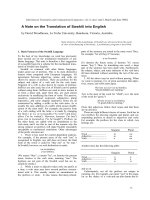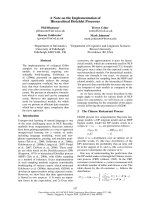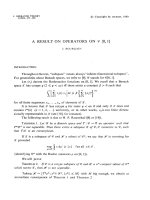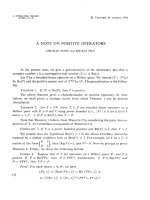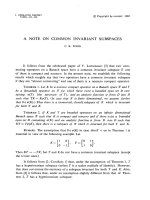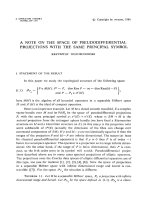Báo cáo toán học: "A Remark on the Dirichlet Problem" pdf
Bạn đang xem bản rút gọn của tài liệu. Xem và tải ngay bản đầy đủ của tài liệu tại đây (131.38 KB, 8 trang )
Vietnam Journal of Mathematics 33:3 (2005) 335–342
A Remark on the Dirichlet Problem
*
Pham Hoang Hiep
Department of Mathematics, Hanoi University of Education,
136 Xuan Thuy Str eet, C au Giay, Hanoi, Vietnam
Received October 06, 2004
Revised March 03, 2005
Abstract. Given a positive measure μ on a strongly p seudoconvex domain in C
n
.We
study the Dirichlet problem
(dd
c
u)
n
= μ in a new class of plurisubharmonic function.
This class includes the classes
E
p
(p ≥ 1) introduced by Cegrell in [5].
1. Introduction.
Let Ω be a bounded domain in C
n
.ByPSH(Ω) we denote the set of plurisub-
harmonic (psh) functions on Ω. By the fundamental work of Bedford and Taylor
[1, 2], the complex Monge-Ampere operator (dd
c
)
n
is well defined over the class
PSH(Ω) ∩ L
∞
loc
(Ω) of locally bounded psh functions on Ω, more precisely, if
u ∈ PSH(Ω) ∩ L
∞
loc
(Ω) is a positive Borel measure. Furthermore, this operator
is continuous with respect to increasing and decreasing sequences. Later, De-
mailly has extended the domain of definition of the operator (dd
c
u)
n
to the class
of psh functions which are locally bounded near ∂Ω. Recently in [5, 6], Cegrell
introduced the largest class of upper bounded psh functions on a bounded hyper-
convex domain Ω such that the operator (dd
c
u)
n
can be defined on it. In these
papers, he also studied the Dirichlet problems for the classes F
p
(see Sec. 2 for
details). The aim of our work is to investigate the Dirichlet problem for a new
class of psh function. This class consist, in particular, the sum of a function in
the class E
p
and a function in B
a
loc
(see Sec. 2 for the definitions of these classes).
Now we are able to formulate the main result of our work
∗
This work was supported by the National Research Program for Natural Science, Vietnam
336 Pham Hoang Hiep
Main theorem.
(i) Let Ω be a bounded strongly pseudoconvex domain in C
n
and let μ be a
positive measure on Ω, h ∈ C(∂Ω) such that there exists v ∈
E
p
+ B
a
loc
(resp.
F
p
+ B
a
loc
) with (dd
c
v)
n
≥ μ
Then there exists u ∈
E
p
+ B
a
loc
(resp.
F
p
+ B
a
loc
) such that (dd
c
u)
n
= μ
and lim
z→ξ
u(z)=h(ξ), ∀ξ ∈ ∂Ω.
(ii) There exists f ∈ L
1
(Ω) such that there exists no function u ∈
E
p
+ B
a
loc
which satisfying fdλ ≤ (dd
c
u)
n
.
For the definitions of
E
p
+ B
a
loc
and
F
p
+ B
a
loc
see Sec. 2.
Note that the main theorem for the subclass B of B
a
loc
consisting of psh
functions which are bounded near ∂Ω was proved by Xing in [13] and for the
classes E
p
and F
p
,p≥ 1 by Cegrell in [5].
The key element in the proof of our main theorem is a comparison principle
(Theorem 3.1), which is an extension of Lemma 4.4, Theorem 4.5 in [5].
2. Preliminaries
In this section we recall some elements and results of pluripotential theory that
will be used through out the paper. All this can be found in [2, 3, 5, 6, 11 ].
2.0. Unless otherwise specified, Ω will be a bounded hyperconvex domain in C
n
meaning that there exists a negative exhaustive psh function for Ω .
2.1. Let Ω be a bounded domain in C
n
.TheC
n
-capacity in the sense of Bedford
and Taylor on Ω is the set function given by
C
n
(E)=C
n
(E,Ω) = sup
E
(dd
c
u)
n
: u ∈ PSH(Ω), −1 ≤ u ≤ 0
for every Borel set E in Ω.
2.2. According to Xing (see [13]), a sequence of positive measures {μ
j
} on Ω is
called uniformly absolutely continuous with respect to C
n
in a subset E of Ω if
∀>0, ∃δ>0:F ⊂ E, C
n
(F ) <δ⇒ μ
j
(F ) <, ∀j ≥ 1
We write μ
j
C
n
in E uniformly for j ≥ 1.
2.3. By B
a
loc
= B
a
loc
(Ω) we denote the set of upper bounded psh functions u
which are locally bounded near ∂Ω such that (dd
c
u)
n
C
n
in every E ⊂⊂ Ω.
2.4. The following classes of psh functions were introduced by Cegrell in [5]
and [6]
E
0
= E
0
(Ω) =
ϕ ∈ PSH(Ω) ∩ L
∞
(Ω) : lim
z→∂Ω
ϕ(z)=0,
Ω
(dd
c
ϕ)
n
< +∞
,
E
p
= E
p
(Ω) =
ϕ ∈ PSH(Ω) : ∃E
0
ϕ
j
ϕ, sup
j≥1
Ω
(−ϕ
j
)
p
(dd
c
ϕ
j
)
n
< +∞
,
A Remark o n the Dirichlet Problem 337
F
p
= F
p
(Ω) =
ϕ ∈ PSH(Ω) : ∃E
0
ϕ
j
ϕ, sup
j≥1
Ω
(−ϕ
j
)
p
(dd
c
ϕ
j
)
n
,
< + ∞, sup
j≥1
Ω
(dd
c
ϕ
j
)
n
< +∞
E = E(Ω) =
ϕ ∈ PSH(Ω) : ∀z
0
∈ Ω ∃ a neighborhood ω z
0
, E
0
ϕ
j
ϕ on ω, sup
j≥1
Ω
(dd
c
ϕ
j
)
n
< +∞}.
The following inclusions are obvious E
0
⊂F
p
⊂E
p
⊂E.Itisalsoknown
that these inclusion are strict (see [5, 6]).
The interesting theorem below was proved by Cegrell (see [6])
Theorem 2.5. The class E has the following properties
1. E is a convex cone.
2. If u ∈E,v∈ PSH
−
(Ω) = {ϕ ∈ PSH(Ω) : ϕ ≤ 0},thenmax(u, v) ∈E.
3. If u ∈E,PSH(Ω) ∩L
∞
loc
(Ω) u
j
u, then (dd
c
u
j
)
n
is weakly convergent.
Conversely if K⊂PSH
−
(Ω) satisfies 2 and 3,thenK⊂E
Since B
−
loc
= B
a
loc
∩ PSH
−
(Ω) satisfies 2 and 3 we have by [8] B
−
loc
⊂E.
2.6. Cegrell also studied the following Dirichlet problem: Given μ a positive
measure on Ω, find u ∈F
p
such that (dd
c
u)
n
= μ. He gave a necessary and
sufficient condition for this problem to have a solution (Theorem 5.2 in [5]).
2.7. We define
E
p
+ B
a
loc
=
u ∈ PSH(Ω) : ∃ ϕ ∈E
p
,f∈B
a
loc
: ϕ + f ≤ u ≤ sup
Ω
u<+∞
,
F
p
+ B
a
loc
=
u ∈ PSH(Ω) : ∃ ϕ ∈F
p
,f∈B
a
loc
: ϕ + f ≤ u ≤ sup
Ω
u<+∞
.
It follows that if ϕ + f ≤ u<sup
Ω
u<+∞,ϕ∈E,f∈B
a
loc
then
u − c =max(u − c, ϕ + f − c) ∈E, because ϕ +(f − c) ∈E,
where c =max(sup
Ω
f, sup
Ω
u).
Thus we can define (dd
c
u)
n
for u ∈
E
p
+ B
a
loc
.
2.8. The aim of this work is to study a Dirichlet problem similar to the one
considered by Cegrell but for the classes
E
p
+ B
a
loc
and
F
p
+ B
a
loc
. Namely, given
a positive measure μ on Ω and h ∈ C(∂Ω), find u ∈
E
p
+ B
a
loc
(resp.
F
p
+ B
a
loc
)
such that (dd
c
u)
n
= μ and lim
z→ξ
u(z)=h(ξ) ∀ξ ∈ ∂Ω.
2.9. Let μ be a positive measure on Ω and h ∈ C(∂Ω). Following Cegrell, we
define
338 Pham Hoang Hiep
B(μ, h)={v ∈ PSH(Ω) ∩ L
∞
loc
(Ω) : (dd
c
v)
n
≥ μ, lim
z→ξ
v(z) ≤ h(ξ)},
U(μ, h)(z)=sup{v(z):v ∈ B(μ, h)} ,z∈ Ω.
Observe that B(μ, h) = ∅ implies that μ vanishes on pluripolar sets. The
function U (μ, h) plays a crucial role in solving the Dirichlet problem.
3. The Comparison Principle for
E
p
+ B
a
loc
In order to prove the main theorem, in this section we prove the following
comparison principle
Theorem 3.1. Let u, v be functions in
E
p
+ B
a
loc
satisfying
lim
z→∂Ω
[u(z) − v(z)] ≥ 0.
Then
{u<v}
(dd
c
v)
n
≤
{u<v}
(dd
c
u)
n
.
We need the following result
Lemma 3.2. Let PSH(Ω) ∩ L
∞
(Ω) u
j
u. Assume that
lim
s→+∞
s
n
C
n
({u<−s}∩D)=0, ∀D ⊂⊂ Ω.
Then (dd
c
u
j
)
n
C
n
in every D ⊂⊂ Ω uniformly for j ≥ 1.
Proof. Given D ⊂⊂ Ω. Without loss of generality we may assume that D
is hyperconvex and u
j
≤ 0onD. By [6] for each j ≥ 1thereexistsu
k
j
∈
PSH(D) ∩ C(
¯
D) such that u
k
j
u
j
on D and u
k
j
=0on∂D.Asin[9]for
every k, j ≥ 1ands>0 put
D
kj
(s)={u
k
j
< −s}∩D, D
j
(s)={u
j
< −s}∩D, D(s)={u<− s}∩D,
a
kj
(s)=C
n
(D
kj
(s)),a
j
(s)=C
n
(D
j
(s)),a(s)=C
n
(D(s)),
b
kj
(s)=
D
kj
(s)
(dd
c
u
k
j
)
n
,b
j
(s)=
D
j
(s)
(dd
c
u
j
)
n
.
For 0 <s<twe have max(u
k
j
, −t)=u
k
j
on {u
k
j
> −t} an open neighborhood
of ∂D
kj
(s). It follows that
a
kj
(s) ≥ t
−n
D
kj
(s)
(dd
c
max(u
k
j
, −t))
n
= t
−n
D
kj
(s)
(dd
c
u
k
j
)
n
= t
−n
b
kj
(s).
A Remark o n the Dirichlet Problem 339
Letting t s we get
s
n
a
kj
(s) ≥ b
kj
(s)fork,j ≥ 1ands>0. (1)
Given >0. By the hypothesis there exists s
0
> 0 such that
s
n
0
a(s
0
) <. (2)
Let E ⊂ D with C
n
(E) <
s
n
0
. TakeanopenneighborhoodG of E such that
C
n
(G) <
s
n
0
.Since(dd
c
u
k
j
)
n
→ (dd
c
u
j
)
n
weakly as k →∞we have
E
(dd
c
u
j
)
n
≤
G
(dd
c
u
j
)
n
≤ lim
k→∞
G
(dd
c
u
k
j
)
n
≤ lim
k→∞
[
D
kj
(s
0
)
(dd
c
u
k
j
)
n
+
G\D
kj
(s
0
)
(dd
c
u
k
j
)
n
]
≤ lim
k→∞
[s
n
0
a
kj
(s
0
)+s
n
0
C
n
(G)] ≤ s
n
0
a(s
0
)+<2
for j ≥ 1. Hence (dd
c
u
j
)
n
C
n
in D uniformly for j ≥ 1.
Proof of Theorem 3.1. We may assume that u, v ≤ 0 and lim
z→∂Ω
[u(z) − v(z)] >
δ>0. By hypothesis u, v ∈
E
p
+ B
a
loc
it is easy to find ϕ ∈E
p
,g∈B
−
loc
such
that ϕ + g ≤ min(u, v). Let ϕ
j
ϕ be a sequence decreasing to ϕ as in the
definition of E
p
.Foreachj ≥ 1 put
g
j
=max(g, −j),u
j
=max(u, ϕ
j
+ g
j
),v
j
=max(v, ϕ
j
+ g
j
).
It follows that g
j
,u
j
,v
j
are bounded and g
j
g, u
j
u, v
j
v.Bythe
comparison principle for bounded psh functions we have
{u
j
<v
k
}
(dd
c
v
k
)
n
≤
{u
j
<v
k
}
(dd
c
u
j
)
n
for k ≥ j ≥ 1.
On the other hand, since
s
n
C
n
({u<−s}∩D) ≤ s
n
C
n
({ϕ<−
s
2
}∩D)+s
n
C
n
g<−
s
2
∩ D
→ 0
as s → +∞ (see [5, 9])
By Lemma 3.2 (dd
c
u
j
)
n
+(dd
c
v
j
)
n
C
n
in every D ⊂⊂ Ω uniformly for
j ≥ 1. Thus by the quasicontinuity of psh functions as Theorem 2.2.6 in [4] we
obtain
{u<v}
(dd
c
v)
n
≤
{u≤v}
(dd
c
u)
n
.
By replacing u by u + δ, δ > 0andthenletδ 0, we have
340 Pham Hoang Hiep
{u<v}
(dd
c
v)
n
≤
{u<v}
(dd
c
u)
n
.
This is the desired conclusion.
From Theorem 3.1, as Corollary 2.2.8 in [4], we get the following dominant
principle.
Corollary 3.3. Assume that u and v are as in Theorem 3.1 and (dd
c
u)
n
≤
(dd
c
v)
n
.Thenu ≥ v.
4.ProofoftheMainTheorem
(i) We can assume v ≤ 0. Since (dd
c
v)
n
vanishes on every pluripolar set in
Ω, by Theorem 6.3 in [5] we can find ψ ∈E
0
and 0 ≤ f ∈ L
1
loc
((dd
c
ψ)
n
)
such that μ = f (dd
c
ψ)
n
.Putμ
k
=min(f,k)(dd
c
ψ)
n
.Thenμ
k
≤ (dd
c
k
1
n
ψ)
n
.
By Theorem 2 in [13] there exists ω
k
∈E
0
such that (dd
c
ω
k
)
n
= μ
k
.The
comparison principle implies that 0 ≥ ω
k
ω ≥ v. Hence ω ∈
E
p
+ B
a
loc
and (dd
c
ω)
n
= μ. We show that lim
z→ξ
ω(z)=0forξ ∈ ∂Ω. Assume the
contrary, then
lim
z→ξ
0
ω(z) < − for some ξ
0
∈ ∂Ω,>0. Take δ>0 such that
ω(z) < − for z ∈ B(ξ
0
,δ) ∩ Ω. Let τ ∈ C(∂Ω) such that τ|
B(ξ
0
,
δ
2
)∩∂Ω
= ,
suppτ ⊂ B(ξ
0
,δ) ∩ ∂Ω. By [2] there exists φ ∈ PSH(Ω) ∩ C(
¯
Ω) such that
(dd
c
φ)
n
=0andφ|
∂Ω
= τ. Since lim
z→ξ
[ω
k
(z) − (ω(z)+φ(z))] ≥ 0forξ ∈ ∂Ω
and (dd
c
ω
k
)
n
= μ
k
≤ μ =(dd
c
ω)
n
≤ (dd
c
(ω + φ))
n
,wehaveω
k
≥ ω + φ on Ω
for k ≥ 1. Thus ω ≥ ω + φ on Ω. Hence φ ≤ 0onΩ\{ω = −∞}.Sinceφ is
plurisubharmonic, φ ≤ 0 on Ω. This is impossible, because φ(ξ)=τ(ξ)= for
ξ ∈ B(ξ
0
,
δ
2
) ∩ ∂Ω. Hence lim
z→ξ
ω(z)=0forξ ∈ ∂Ω. From the relations
U((dd
c
(ω
k
+ U (0,h)))
n
,h)=ω
k
+ U (0,h),
(dd
c
(ω + U(0,h)))
n
≥ μ
k
,
and from Theorem 8.1 in [5] it follows that
(dd
c
U(μ
k
,h))
n
= μ
k
,
U(0,h) ≥ U(μ
k
,h) ≥ ω
k
+ U (0,h).
Theorem 3.1 implies that U (μ
k
,h) u ∈
E
p
+ B
a
loc
with (dd
c
u)
n
= μ and
U(0,h) ≥ u ≥ ω + U(0,h). Thus for ξ ∈ ∂Ωwehave
h(ξ)=
lim
z→ξ
U(0,h) ≥ lim
z→ξ
u(z) ≥ lim
z→ξ
[ω(z)+U (0,h)(z)]
=
lim
z→ξ
ω(z) + lim
z→ξ
U(0,h)(z)=h(ξ).
Consequently u ∈
E
p
+ B
a
loc
such that (dd
c
u)
n
= μ and lim
z→ξ
u(z)=h(ξ) ∀ξ ∈
∂Ω.
A Remark o n the Dirichlet Problem 341
(ii) Let {Ω
j
} be an increasing exhaustion sequence of strongly pseudoconvex
subdomains of Ω. For each j ≥ 1 take a sequence of distinguished points
z
jm
⊂ Ω
j
\Ω
j−1
converging to ξ
j
∈ ∂Ω
j
as m →∞and a sequence s
j
0such
that B(z
jm
,s
jm
)⊂ Ω
j
\Ω
j−1
and B(z
jm
,s
jm
) ∩ B(z
jt
,s
jt
)=∅ for m = t.Let
a
jm
> 0with
∞
j,m=1
a
jm
< ∞.Put
f =
j,m≥1
a
jm
d
n
r
2n
jm
χ
B(z
jm
,r
jm
)
,
where 0 <r
jm
<s
jm
are chosen such that
1
a
jm
(C
n
(B(z
jm
,r
jm
), Ω))
p
n+p
→ 0asm →∞,
for j ≥ 1andd
n
is the volume of the unit ball in C
n
.
Assume that fdλ ≤ (dd
c
u)
n
for some u ∈
E
p
+ B
a
loc
.Takeϕ ∈E
p
,g∈B
a
loc
such that ϕ+g ≤ u ≤ sup
Ω
u<+∞. We may assume that g and u are negative.
Let j
0
≥ 2andM>0 such that g>−M on Ω
j
0
\Ω
j
0
−1
.
Put
˜g =max(g, Ah
Ω
j
0
)whereA = −
M
sup
¯
Ω
j
0
h
Ω
j
0
> 0.
It follows that ˜g ∈E
0
, ˜g = g on Ω
j
0
\Ω
j
0
−1
.
Let ˜u =max(u, ϕ +˜g). Since ϕ +˜g ≤ ˜u ≤ 0andϕ +˜g ∈E
p
+ E
0
= E
p
,by
[5] we have ˜u ∈E
p
.
Moreover ˜u = u on Ω
j
0
\Ω
j
0
−1
.ThusforB
m
= B(z
j
0
m
,r
j
0
m
)wehave
a
j
0
m
=
B
m
fdλ =
B
m
(dd
c
u)
n
=
B
m
(dd
c
˜u)
n
.
Let ˜u
k
˜u as in the definition of E
p
.Then(dd
c
˜u
k
)
n
→ (dd
c
˜u)
n
weakly (see
[5]). Applying the Holder inequality (see [7]) we have
a
j
0
m
=
B
m
(dd
c
˜u)
n
≤ lim
k→∞
B
m
(dd
c
˜u
k
)
n
= lim
k→∞
B
m
(−h
B
m
)
p
(dd
c
˜u
k
)
n
≤ α
1
lim
k→∞
[
Ω
(−h
B
m
)
p
(dd
c
h
B
m
)
n
]
p
n+p
[
Ω
(−˜u
k
)
p
(dd
c
˜u
k
)
n
]
n
n+p
≤ α
2
[
Ω
(dd
c
h
B
m
)
n
]
p
n+p
= α
2
[C
n
(B
m
, Ω)]
p
n+p
,
where α
2
= α
1
[sup
k≥1
Ω
(−˜u
k
)
p
(dd
c
˜u
k
)
n
]
n
n+p
< +∞. This is impossible, because
342 Pham Hoang Hiep
lim
m→∞
[C
n
(B
m
, Ω)]
p
p+n
a
j
0
m
=0.
Remark. Using Theorem 7.5 in [1] we can find u ∈F
a
such that (dd
c
u)
n
=
fdλ where f is constructed as in (ii). Hence, there exists a function u in
F
a
\ (
ξ
p
+ B
a
loc
).
Acknowledgements. The author is grateful to Professor Nguyen Van Khue for sug-
gesting the problem and for many helpful discussion during the preparation of this
work.
References
1. P.
˚
Ahag, The Complex Monge–Ampere Operator on Bounded Hyperconvex Do-
mains, Ph. D. Thesis, Ume ˚a University, 2002.
2. E. Bedford and B. A. Taylor, The Dirichlet problem for the complex Monge-
Ampere operator, Invent. Math. 37 (1976) 1–44.
3. E. Bedford and B. A.Taylor, A new capacity for plurisubharmonic function, Acta
Math. 149 (1982) 1–40.
4. Z. Blocki, The Complex Monge-Ampere Operator in Pluripotential Theory,Lec-
ture Notes, 1998.
5. U. Cegrell, Pluricomplex energy, Acta Math. 180 (1998) 187–217.
6. U. Cegrell, The general definition of the complex Monge-Ampere operator, Ann.
Inst. Fourier (Grenoble) 54 (2004) 159–179.
7. U. Cegrell and L. Persson, An energy estimate for the complex Monge-Ampere
operator, Annales Polonici Mathematici (1997) 96–102.
8. U. Cegrell, S. Kolodziej, and A.Zeriahi, Subextension of plurisubharmonic func-
tions w ith weak singularities, Math. Zeit. (to appear).
9. J - P. Demailly, Monge-Ampere operators, Lelong Numbers and Intersection the-
ory, Complex Analysis and Geometry, Univ. Ser. Math.,Plenum,NewYork,
1993, 115–193.
10. P. H. Hiep, A characterization of bounded plurisubharmonic functions, Annales
Polonici Math. 85(2005) 233–238.
11. N. V. Khue, P. H. Hiep, Complex Monge-Ampere measures of plurisubharmonic
functions which are locally bounded near the boundary, Preprint 2004.
12. M. Klimek, Pluripotential Theory, Oxford, 1990.
13. Y. Xing, Complex Monge-Ampere measures of pluriharmonic functions with
bounded values near the boundary, Cand. J. Math. 52 (2000) 1085–1100.
